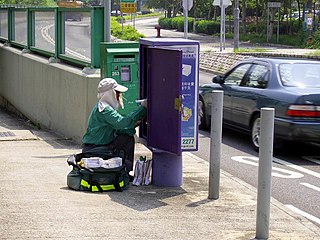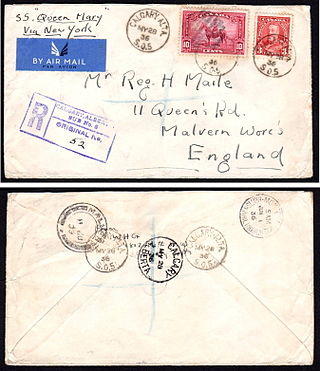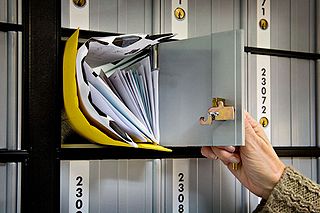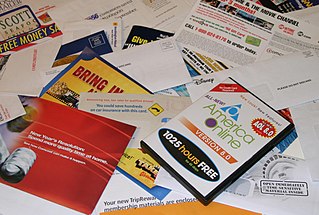
The United States Postal Service (USPS), also known as the Post Office, U.S. Mail, or Postal Service, is an independent agency of the executive branch of the United States federal government responsible for providing postal service in the United States, its insular areas, and its associated states. It is one of the few government agencies explicitly authorized by the Constitution of the United States. As of 2023, the USPS has 525,469 career employees and 114,623 non-career employees.

The mail or post is a system for physically transporting postcards, letters, and parcels. A postal service can be private or public, though many governments place restrictions on private systems. Since the mid-19th century, national postal systems have generally been established as a government monopoly, with a fee on the article prepaid. Proof of payment is usually in the form of an adhesive postage stamp, but a postage meter is also used for bulk mailing.

A ZIP Code is a system of postal codes used by the United States Postal Service (USPS). The term ZIP was chosen to suggest that the mail travels more efficiently and quickly when senders use the code in the postal address.
The Private Express Statutes (PES) are a group of United States federal civil and criminal laws placing various restrictions on the carriage and delivery of letters by all organizations other than the United States Postal Service.

Registered mail is a postal service in many countries which allows the sender proof of mailing via a receipt and, upon request, electronic verification that an article was delivered or that a delivery attempt was made. Depending on the country, additional services may also be available, such as:
Franking comprises all devices, markings, or combinations thereof ("franks") applied to mails of any class which qualifies them to be postally serviced. Types of franks include uncanceled and precanceled postage stamps, impressions applied via postage meter, official use "Penalty" franks, Business Reply Mail (BRM), and other permit Imprints (Indicia), manuscript and facsimile "franking privilege" signatures, "soldier's mail" markings, and any other forms authorized by the 192 postal administrations that are members of the Universal Postal Union.

A post office box is a uniquely addressable lockable box located on the premises of a post office.

Advertising mail, also known as direct mail, junk mail, mailshot or admail, letterbox drop or letterboxing (Australia), is the delivery of advertising material to recipients of postal mail. The delivery of advertising mail forms a large and growing service for many postal services, and direct-mail marketing forms a significant portion of the direct marketing industry. Some organizations attempt to help people opt out of receiving advertising mail, in many cases motivated by a concern over its negative environmental impact.

John E. "Jack" Potter is the president and CEO of the Metropolitan Washington Airports Authority since July 18, 2011. He is the former United States Postmaster General and CEO of the United States Postal Service (USPS), having become the 72nd postmaster general on June 1, 2001. Potter is the second longest-serving postmaster general, following Gideon Granger.

The system for mail delivery in the United States has developed with the nation. Rates were based on the distance between sender and receiver in the nation's early years. In the middle of the 19th century, rates stabilized at one price regardless of distance. Rates were relatively unchanged until 1968 when the price was increased every few years by a small amount. Comparing the increases with a price index, the cost of a first-class stamp has been steady. The seal of the Post Office Department showed a man on a running horse, even as railroads and, later, motorized trucks and airplanes moved mail. In 1971, the Post Office became the United States Postal Service, with rates set by the Postal Regulatory Commission, with some oversight by Congress. Air mail became standard in 1975. In the 21st century, prices were segmented to match the sorting machinery used; non-standard letters required slightly higher postage.
Within the United States, a commercial mail receiving agency (CMRA) is a private business that accepts mail from the Postal Service on behalf of third parties. A CMRA may also be colloquially known as a mail drop. A mailbox at a CMRA is called a private mailbox (PMB).

Parcel post is a postal service for mail that is too heavy for normal letter post. It is usually slower than letter post. The development of the parcel post is closely connected with the development of the railway network which enabled parcels to be carried in bulk, to a regular schedule, and at economical prices. Today, many parcels also travel by road and international shipments may travel by sea or airmail.
An optional information line is a line above the postal address on mail in the United States. The lines are usually seen on bulk mail to indicate the sorting and separation that allows the mail to have a lower postal rate.
Printed matter is a term, mostly used by mailing systems, normally used to describe mechanically printed materials for which reduced fees are paid which are lower than first-class mail. Each postal administration has its own rules for what may be posted as printed matter. In the Great Britain a special "Book Post" was introduced in 1848 that by 1852 had been extended to the wider range of material.

The Intelligent Mail Barcode (IMb) is a 65-bar barcode for use on mail in the United States. The term "Intelligent Mail" refers to services offered by the United States Postal Service for domestic mail delivery. The IM barcode is intended to provide greater information and functionality than its predecessors POSTNET and PLANET. An Intelligent Mail barcode has also been referred to as a One Code Solution and a 4-State Customer Barcode, abbreviated 4CB, 4-CB or USPS4CB. The complete specification can be found in USPS Document USPS-B-3200. It effectively incorporates the routing ZIP Code and tracking information included in previously used postal barcode standards.
National Change of Address (NCOALink) "is a secure dataset of approximately 160 million permanent change-of-address (COA) records consisting of the names and addresses of individuals, families and businesses who have filed a change-of-address with the USPS". It is maintained by the United States Postal Service and access to it is licensed to service providers and made available to mailers. There are six licenses available including Full Service Providers and Limited Service Providers. The use of NCOALink is required in order to obtain bulk mail rates, as it minimizes the number of UAA mailpieces saving the mailer money and reducing the USPS's processing of this type of mail.

Mail sorting refers to the methods by which postal systems determine how and where to route mail for delivery. Once accomplished by hand, mail sorting is now largely automated through the aid of specialized machines. The first widely adopted mail sorting machine was the Transorma, first made operational in Rotterdam in 1930.

The Post Office Box Lobby Recycling program is a project of the United States Postal Service (USPS) that was created on October 28, 2008, for mail customers to recycle paper items, using recycling bins placed in the customer lobbies of post office buildings. Some of the goals of the program are to reduce the amount of paper waste going to landfills, which helps to reduce the consumption of fiber from trees used for paper production and greenhouse gas emissions associated with waste disposal. USPS receives revenue from selling the material, and no tax dollars are used to fund the project. USPS was reported as having recycled over 200,000 short tons of waste in 2009, including paper, plastics and other waste.
A network distribution center (NDC) was a highly mechanized mail processing plant of the United States Postal Service that distributed standard mail and package services in piece and bulk form. The NDC network was dismantled in 2022-2023 by the USPS as part of Postmaster General Louis DeJoy’s Delivering for America network rationalization plan, which saw mail classes formerly handled by the NDC network merged into mailstreams in processing and distribution centers. Each former NDC, all of which were located in buildings owned by USPS, are implementing or in the process of creating individual plans for repurposing the buildings. Many are being restacked into RPDCs, which will form the backbone of the new USPS network, whereas others are being used to insource previously outsourced transportation functions such as surface transfer centers (STCs), or terminal handing services (THS), which handled airmail, in addition to continuing to support processing and distribution centers with the handing of priority and ground advantage parcels.

Louis DeJoy is an American businessman serving as the 75th U.S. postmaster general. He was appointed in May 2020 by the Board of Governors of the United States Postal Service (USPS). Prior to the appointment, he was the founder and CEO of the logistics and freight company New Breed Logistics and was a major Republican Party donor and fundraiser for Donald Trump. DeJoy is the first postmaster general since 1992 without any previous experience in the USPS. His companies still hold active service contracts with the USPS, generating controversy over conflict of interest.













